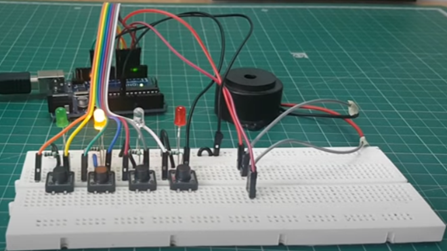Project No. 22: Creating a Automatics Smart Bridge
1. Introduction:
Welcome to the world of smart infrastructure with our innovative
project, the Smart Bridge. This project aims to revolutionize the functionality
of bridges by incorporating automation and real-time data to ensure safe and
efficient passage over water bodies. By utilizing a moisture sensor and servo
motors, the Smart Bridge system intelligently adjusts the bridge height based
on water levels, providing a seamless experience for travelers.Traditional
bridges often rely on manual intervention to adjust their height in response to
changing water levels. This process can be time-consuming, inefficient, and
potentially unsafe. Our Smart Bridge project addresses these challenges by
automating the height adjustment process, eliminating the need for manual
operation and reducing the risk of human error.
At the core of our project is a moisture sensor strategically
placed near the water body, such as a river or canal. This sensor continuously
monitors the moisture levels in the surrounding area, providing real-time data
on water levels. When the water level reaches or exceeds a predefined
threshold, indicating a need for a higher bridge, the moisture sensor sends a
signal to the control system.
Traditional
bridges often rely on manual intervention to adjust their height in response to
changing water levels. This process can be time-consuming, inefficient, and
potentially unsafe. Our Smart Bridge project addresses these challenges by
automating the height adjustment process, eliminating the need for manual
operation and reducing the risk of human error.
At the core of our project is a moisture sensor strategically placed near the water body, such as a river or canal. This sensor continuously monitors the moisture levels in the surrounding area, providing real-time data on water levels. When the water level reaches or exceeds a predefined threshold, indicating a need for a higher bridge, the moisture sensor sends a signal to the control system.
2. Working:
2. Working:
Step1: Setup:Begin by setting up the components required
for the Smart Bridge system. This includes a moisture sensor, two servo motors,
a microcontroller (such as Arduino), a power supply, and the bridge mechanism
itself. Ensure proper wiring connections and configurations are in place.
Step2: Moisture Detection:Position the moisture sensor near the water
body, where it can accurately detect the moisture levels in the surrounding
area. The sensor continuously measures the moisture content, which correlates
with the water level. As the water level rises, the moisture sensor detects the
increase and provides corresponding data to the control system.
The control system, powered by the
microcontroller, receives the data from the moisture sensor. It processes this
information and determines whether the water level has exceeded the predefined
threshold for bridge adjustment.
Step3: Servo Motor Operation: If the water level reaches or exceeds the
threshold, indicating the need for a higher bridge, the control system
activates both servo motors simultaneously. These motors work together to
adjust the bridge height. They are connected to the bridge mechanism and
capable of raising or lowering it in a coordinated manner.
Step4: Coordinate Bridge Adjustment: The synchronized operation of the servo motors
ensures that the bridge elevates or descends smoothly and evenly. This
coordinated movement prevents any tilting or imbalances that could pose risks
to vehicles or pedestrians crossing the bridge.
Step4: Continues Monitoring: The control system continuously monitors the
moisture sensor data to track any changes in the water level. It periodically
checks the moisture readings to ensure accurate detection of the water level
and to maintain the optimal bridge height.
3. What is Moisture Sensor?
A moisture sensor, also known as a soil moisture sensor or moisture meter, is a device used to measure the moisture content in soil or other materials. It is commonly used in agriculture, gardening, and environmental monitoring to determine the water content of the soil and help optimize irrigation practices.
4. Things that you will get with models:
1. Detailed Model
2. Well soldered circuits
3. PPT4. All things as shown above
2. Well soldered circuits




Comments
Post a Comment